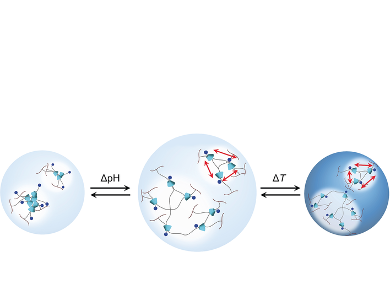In conventional thermo- and pH-responsive microgels, the individual modes of response usually interfere with each other. This is an unsolved problem for such smart materials. An example is the uncontrollable deswelling that occurs in the presence of oppositely charged molecules.
Toshikazu Takata, Tokyo Institute of Technology, Japan, and Daisuke Suzuki, Shinshu University, Nagano, Japan, and colleagues have developed rotaxane cross-linked (RC) microgels that show a decoupled thermo- and pH-responsive volume transition. They introduced rotaxane cross-linkers during the precipitation polymerization, which minimizes the disintegration of the mechanically cross-linked structure.
The researchers used the pH-induced changes of the aggregation/disaggregation states of cyclodextrin in the RC networks to control the swelling capacity of the entire microgels. The driving forces for the aggregation/disaggregation of cyclodextrins in RC are hydrogen bonds that develop in acidic or neutral solutions, whereby the hydrogen bonds may be weakened in aqueous alkali solution.
Even in the presence of charged functional molecules such as dyes in the microgel dispersion, the RC microgels respond to temperature as intended. The RC-linking points in the microgels, charged functional molecules are adsorpted.
According to the researchers, such RC microgel systems should be suited to a variety of vinyl monomers. The studies may lead to new applications, including drug delivery systems that require a retention of their smart functions even in environments that may contain foreign ions, for example, in in vivo experiments.
- Decoupled Thermo- and pH-Responsive Hydrogel Microspheres Cross-Linked by Rotaxane Networks,
Takuma Kureha, Daichi Aoki, Seina Hiroshige, Keisuke Iijima, Daisuke Aoki, Toshikazu Takata, Daisuke Suzuki,
Angew. Chem. Int. Ed. 2017.
https://doi.org/10.1002/anie.201709633




